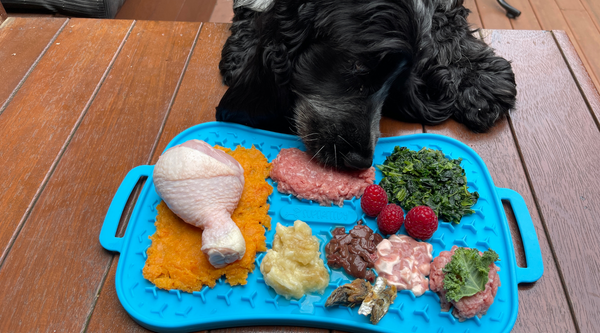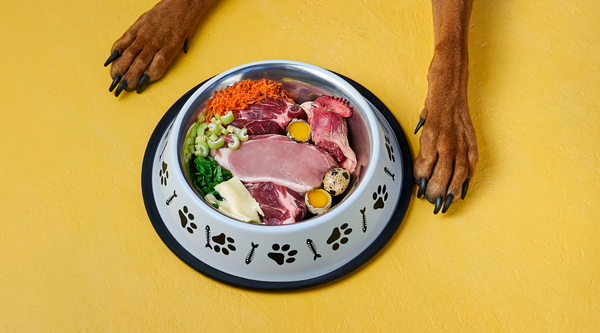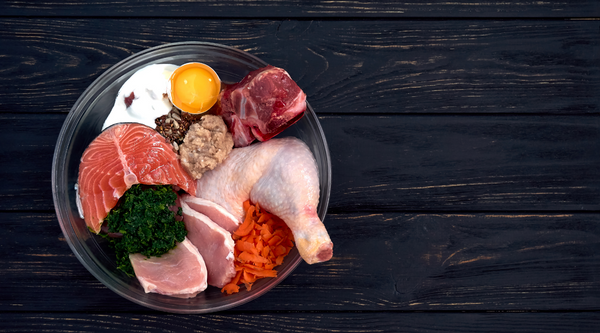What is the BARF Diet?
BARF stands for Bones and Raw Food or Biologically Appropriate Raw Food Diet. BARF is a raw diet designed to provide dogs with a homemade diet of raw meaty bones, raw muscle meat, liver and other secreting organs vegetables and fruits. It is fresh food, free of any added preservatives or artificial ingredients. In general, the BARF diet is the most popular model of a raw diet for dogs.
In BARF diets, raw meats, bones, vegetables, fruits, herbs, dairy, whole grains, minerals, and supplements are all in fresh, uncooked form. Your dogs' health can be significantly improved by raw dog food diets, which contain more protein and nutrients than most commercial pet foods.
The BARF diet is based on the idea that dogs are scavengers and, as such, are designed to eat a diet that is high in protein and low in carbohydrates. The BARF diet mimics the diet dogs ate in the wild before becoming domesticated.

In 1993, Australian veterinarian Ian Billinghurst published his best-seller "Give Your Dog a Bone: The Practical Commonsense Way to Feed Dogs for a Long and Healthy Life". As a result, vets, nutrition experts, and dog owners worldwide have steadily endorsed the BARF diet.
There are several benefits of feeding your dog a BARF diet, including improved digestion, reduced allergies, and maintaining an ideal weight. BARF diets are also thought to provide dogs with more energy, enhance their joint health, and bolster their immune system.
This guide will provide you with everything you need to know about the BARF diet for dogs, including the benefits and drawbacks of this type of diet, how to get started, and tips for transitioning your dog from dry food to raw food diet at meal time.
BARF Diet for Dogs: What's in this raw dog food diet?
BARF diets have gained popularity over the years. This evolutionary diet replicates what a dog would eat in nature. There are different types of raw dog food diets, including those consisting primarily of uncooked meat and bones (RMBDs) and those following the "prey model" diet.
As a dog owner, you may be considering the BARF diet for your furry friend. Typically, raw diets follow this formula:
- 70% uncooked muscle meat;
- 10% raw, edible bone;
- 5% liver;
- 5% other secreting organs;
- 10% vegetables and fruit of the overall daily intake.
A good source of protein is muscle meat, and protein contains essential amino acids, a dog's building blocks.
Proteins
Proteins in a BARF diet can include lean cuts of beef, turkey or pork (depending on what your dog tolerates) and organ meats such as liver and kidney. You may also feed your dog whole or ground raw meaty bones (never cooked), fish (not more than once a week), and raw eggs (shells and egg yolks).
Vegetables
BARF diets typically include fresh produce such as broccoli, cabage, squash, pumpkin, spinach, leafy greens, and carrots. You'll want to avoid onions and avocados, which can harm dogs.
Fruits
Fruit such as apples, bananas, cranberries, and blueberries are also often included in BARF diets, but you'll want to steer clear of raisins and grapes, which can be toxic for dogs.
Fresh herbs
Fresh herbs such as parsley, basil, and oregano may also be used.
It's essential to get the proportions correct when feeding a raw diet so that your dog gets the right blend of nutrients.

BARF Diet: What Are The Benefits?
The health benefits of raw feeding dogs are endless. Some of these include:
- improved digestion and nutrient absorption
- less odour increased energy levels and stamina
- stronger bones and cleaner teeth (& fresher breath) due to the increased calcium intake
- healthier skin and shinier coats due to the high level of omega fatty acids
- reduced allergies due to the elimination of processed foods
- improved joint health due to the increased glucosamine and chondroitin sulphate levels
- weight management due to natural ingredients that are low in calories
- reduced risk of cancer due to lack of artificial preservatives and colouring agents
- dogs can benefit from a raw diet because their bodies can utilise them more, making their stools smaller and less smelly.
How to Prepare a BARF Diet for Dogs

If you're thinking of switching your dog to raw meals as part of a BARF raw meat diet, it's important to do your research, understand the nutritional requirements and key nutrients and make sure you're prepared to properly feed your pup. Here are 12 tips to help you prepare:
1. Introduce the diet slowly. Switching your dog to a raw diet overnight can cause digestive upset, so it's best to introduce the BARF diet gradually over several days or weeks.
2. Keep your dog's usual feeding schedule. If you fed your dog once a day before going raw, feed them once daily now. If your dog ate twice a day before the raw diet, stick with that feeding routine.
3. Weigh portions. Healthy adult dogs should eat 2-3% of their body weight in raw food per day (not per meal). You may need to adjust portions slightly if your dog quickly gains or loses too much weight on the raw diet.
4. Feed whole cuts of meat. Rather than cutting meat into bite-size pieces, feed your dog more significant, whole cuts of meat. This will help them to better digest the food and keep their teeth clean.
5. Include a variety of meats in your dog's diet. BARF diets should be varied, so include and rotate different types of sources of protein in your pup's diet, including poultry, red meat and fish.
6. Feed raw bones, an excellent source of minerals, no cooked bones. Raw bones are an essential part of the BARF diet and provide rich nutrients and help with dental health. Depending on your dog's breed, size, and age, stick to small bones like chicken wings and necks, as larger bones can cause choking or digestive problems. Always supervise your dog when you give them a bone.
7. Add plenty of fruits and vegetables. Along with meat, fruits and vegetables are an essential part of the BARF diet and provide essential vitamins, minerals, and antioxidants. Be sure to puree, chop, or grate fruits and vegetables, so they're easy for your pup to digest.
8. Offer dairy products. Raw dairy products like yogurt and cheese (dog safe only) are a healthy addition to the BARF diet and provide many essential nutrients.
9. Supplement with vitamins and minerals. Depending on what foods you include in your dog's BARF diet, you may need to supplement with specific vitamins and minerals. Consult with your holistic veterinarian to determine which supplements are best for your pup's stage of life.
10. Feed fresh, not frozen food and thaw food before serving. Frozen food can stay fresh in the fridge for up to two days (or in the freezer for six months) if properly sealed. When feeding raw food to your dog, always check the expiration date to ensure the food is fresh.
11. Store raw food properly. Raw meat should be stored in the fridge or freezer and kept away from other foods to prevent cross-contamination. Be sure to wash your hands and all food preparation surfaces after handling raw meat.
12. Monitor your dog's stool. A soft stool can indicate that you need to adjust your dog's diet ingredients. If you notice any changes in your dog's stool, consult with a holistic veterinarian for guidance.
Is a BARF Diet Risky?

Like any type of raw food diet, there are also some potential risks associated with the BARF diet, such as the risk of bacterial contamination and potential problems with calcium absorption that may cause issues in dogs. It's important to talk to your vet before switching your dog to a BARF diet and to follow their guidelines for creating a balanced BARF diet.
If you're considering switching your dog to a raw food diet, it's essential to do your research to ensure you can provide them with the nutrients and dietary requirements.
There are a lot of misconceptions and myths floating around. Some people believe that BARF diets with raw ingredients are risky business and can lead to food-borne illnesses in dogs. Others may be concerned about their dog ingesting whole bones, potentially choking or other health hazards. And still, others may feel that BARF diets are an unbalanced diet for their dog.
Raw meat carries bacteria like e.coli and salmonella, but these bacteria are not as harmful to dogs as they are to humans. Dogs also have shorter transit times than humans do, meaning that the bacteria don't have time to grow and cause clinical diseases. However, feeding your dog a BARF diet is a safe and healthy option with proper precautions.
Finally, BARF diets can be a well-balanced diet for your dog if you do your research and make sure you're including all the necessary nutrients. Many raw dog food diet companies offer complete and balanced BARF diets for dogs. So if you're not sure where to start, there are many commercial dog foods on the market that make their own raw dog food recipes.
Tips for Transitioning Your Dog to a Raw Food Diet

Switching your dog to a raw pet food diet can be tricky, but it can be done successfully with patience and planning. Here are some tips for transitioning your dog to a BARF diet to avoid an upset stomach:
- Start by adding small amounts of raw food to their regular dry food and gradually increasing the raw food percentage over time. This will help prevent gastrointestinal problems when switching dogs to a new diet.
- Make sure the raw food you are feeding your dog is nutritionally balanced and includes a variety of animal and plant-based ingredients.
- Follow your veterinarian's guidelines for creating a BARF diet that meets your dog's specific nutritional needs.
- Lean meats promote a healthy weight and are beneficial ingredients in BARF diets.
- As for whole bones, it's important to feed only raw bone, edible bone with lots of joints, like necks, tails and feet.
- Transition slowly, adding new BARF diet meals one at a time so your dog can get used to the change.
- If you're not comfortable preparing BARF diet meals for your dog, you can purchase commercially prepared BARF diets from various sources.
- Many other healthy ingredients might be added to a homemade raw diet for dogs, including whole eggs, kelp or spirulina, coconut oil, turmeric, and anything else beneficial to their health.
If you are unsure about what is safe and what isn't, essential nutrients to include/ exclude, consult with an expert in canine nutrition or your local vet.
Conclusion
Getting the nutritional balance right is critical when preparing fresh, healthy food for dogs. A balanced diet will depend upon several factors, such as the age of your dog, his health, and his current condition.
There are a lot of benefits to feeding your dog BARF food, but it's essential to do your research before starting the diet to understand how it can help and ensure your dog is getting balanced nutrition on a raw food diet. There are a lot of specific instructions that need to be followed to make sure your dog has dietary variety and maximum nutrition regardless of breed, size and age.
While it's essential to be aware of the risks of following a raw food diet for dogs, you can significantly minimise these risks by following safe food handling practices.
Talk to your veterinary nutritionist or animal nutritionist if you're thinking of feeding your pup raw food to understand and clear up any health concerns to ensure they receive adequate nutrition to support their growth and development.
At Super Feedy, we launched a new innovative, versatile 4-in-1 slow feeder dog bowl and reversible lick mat perfect for helping you serve delicious BARF food for your dog. Very soon we will also have some BARF diet recipes following the BARF model diet to give you ideas for a balanced meal.
Changing The Way Dogs Eat for Good!
As responsible pet parents, we know that you want to do everything to help. Living with a sick dog after a meal is no fun. Our two doggos, Marley and Belle, both like to eat fast! So we know exactly what it's like to live with a dog in pain and discomfort after eating.
We are introducing the Ultimate, Versatile 4-in-1 Slow Feeder Dog Bowl! We're excited this new slow feeder dog bowl combines modern design with innovative functionality. It's more than just a slow feeder. A slow feeder bowl that naturally slows your dog down at chow time, as well as a reversible lick mat so your pet can enjoy a variety of delicious foods like purees, stews, or wet food. An excellent bowl for easy delicious food prep and storage doubles as a dog-friendly travel bowl for your canine adventures.
Your dog will have a happier, healthier mealtime experience giving you peace of mind.
Transform Mealtime with Super Feedy's 4-in-1 Slow Feeder Dog Bowl
Enhance your dog's dining experience with Super Feedy's innovative 4-in-1 Slow Feeder Dog Bowl. This versatile design functions as a slow feeder, reversible lick mat, food prep, and travel bowl, promoting healthier eating habits and providing mental stimulation. Made from durable, non-toxic materials with a stable suction base, it's perfect for medium and large dogs.




